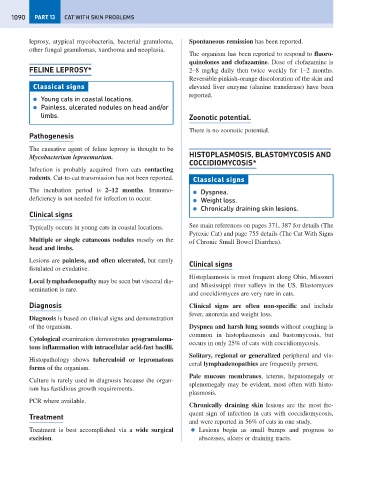Page 1098 - Problem-Based Feline Medicine
P. 1098
1090 PART 13 CAT WITH SKIN PROBLEMS
leprosy, atypical mycobacteria, bacterial granuloma, Spontaneous remission has been reported.
other fungal granulomas, xanthoma and neoplasia.
The organism has been reported to respond to fluoro-
quinolones and clofazamine. Dose of clofazamine is
FELINE LEPROSY* 2–8 mg/kg daily then twice weekly for 1–2 months.
Reversible pinkish-orange discoloration of the skin and
Classical signs elevated liver enzyme (alanine transferase) have been
reported.
● Young cats in coastal locations.
● Painless, ulcerated nodules on head and/or
limbs. Zoonotic potential.
There is no zoonotic potential.
Pathogenesis
The causative agent of feline leprosy is thought to be
HISTOPLASMOSIS, BLASTOMYCOSIS AND
Mycobacterium lepraemurium.
COCCIDIOMYCOSIS*
Infection is probably acquired from cats contacting
rodents. Cat-to-cat transmission has not been reported. Classical signs
The incubation period is 2–12 months. Immuno- ● Dyspnea.
deficiency is not needed for infection to occur. ● Weight loss.
● Chronically draining skin lesions.
Clinical signs
Typically occurs in young cats in coastal locations. See main references on pages 371, 387 for details (The
Pyrexic Cat) and page 755 details (The Cat With Signs
Multiple or single cutaneous nodules mostly on the of Chronic Small Bowel Diarrhea).
head and limbs.
Lesions are painless, and often ulcerated, but rarely
Clinical signs
fistulated or exudative.
Histoplasmosis is most frequent along Ohio, Missouri
Local lymphadenopathy may be seen but visceral dis-
and Mississippi river valleys in the US. Blastomyces
semination is rare.
and coccidiomyces are very rare in cats.
Diagnosis Clinical signs are often non-specific and include
fever, anorexia and weight loss.
Diagnosis is based on clinical signs and demonstration
of the organism. Dyspnea and harsh lung sounds without coughing is
common in histoplasmosis and bastomycosis, but
Cytological examination demonstrates pyogranuloma-
occurs in only 25% of cats with coccidiomycosis.
tous inflammation with intracellular acid-fast bacilli.
Solitary, regional or generalized peripheral and vis-
Histopathology shows tuberculoid or lepromatous
ceral lymphadenopathies are frequently present.
forms of the organism.
Pale mucous membranes, icterus, hepatomegaly or
Culture is rarely used in diagnosis because the organ-
splenomegaly may be evident, most often with histo-
ism has fastidious growth requirements.
plasmosis.
PCR where available.
Chronically draining skin lesions are the most fre-
quent sign of infection in cats with coccidiomycosis,
Treatment
and were reported in 56% of cats in one study.
Treatment is best accomplished via a wide surgical ● Lesions begin as small bumps and progress to
excision. abscesses, ulcers or draining tracts.

